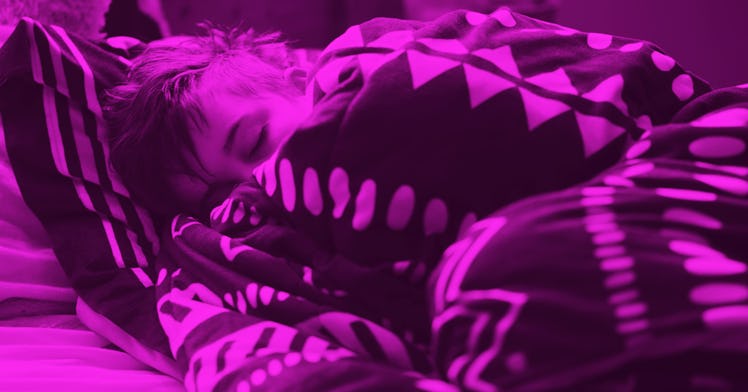This Circadian Lighting Sleep Hack Gives Teens 50 Minutes More Rest a Night
A combination of flashing lights and talk therapy may be the secret to getting teens to sleep at night.

A unique combination of light and cognitive behavioral therapy can help tired, angsty teens get 43 more minutes of sleep a night, new research out of Stanford University reveals. This matters a great deal, as sleep deprivation among teenagers is more than a parental concern, but a public health one as well. For healthy adolescent brain development, teens need 10 hours of sleep, something 87 percent of them don’t get. The consequences incurred from this range from poor grades and an inability to concentrate in class, to drowsy-driving and car accidents, to anxiety, depression, and an increased risk for attempting suicide.
“There are many risks to sleep loss in teens,” study coauthor Jamie Zeitzer, an associate professor of psychiatry and behavioral sciences and Stanford’s School of Medicine, told Fatherly. “A single night of inadequate sleep is unlikely to have significant long-term health effects, though it would cause next-day fatigue, issues with mood regulation, changes in metabolic needs, and reduced cognitive physical and mental performance.”
It is not exactly the fault of teenagers and there is a specific scientific reason they are not sleeping well. And no, it’s not smartphones, or screen time, although these factors exacerbate the issue. The primary problem is that their circadian rhythms are off. Teens circadian clocks are naturally set later in teens compared to children and adults. Since they are wired to get tired later at night but have to get up for school and other commitments, they are set up to be sleep deprived. Obvious interventions like starting school later have been debated among parents and professionals, but Zeitzer and his colleagues wondered if they could reset teenagers’ internal clocks instead? Past research on jet lag suggested that light therapy, flashes of light during the final three hours of their sleep period design to alter their circadian rhythms, may be one way to accomplish this.
Zeitzer and his colleagues first tested light therapy on 72 teenagers ages 14 to 18 for four weeks. Half of the participants were exposed to frequent light flashes of light during intended to shift their internal clocks, and half were exposed to three bright flashes of light as a placebo, or sham light therapy, which was not enough to produce the same effects. Teens who experienced light therapy reported being more tired at night but this was not enough to change their behaviors. Then researchers conducted a second experiment with an additional 30 teenagers, again, half who were exposed to light therapy and half were exposed to sham light therapy. The difference was that subjects also participated in four one-hour sessions of cognitive behavioral therapy (CBT) focused on encouraging better sleep habits. For instance, during therapy teens were asked to identify areas of their lives that they cared about, such as physical appearance or athletic and academic performance, and used these to motivate them to try to go to bed earlier. During sessions, participants were also given information about sleepy hygiene, their body clocks, and strategies for waking up earlier on weekends.
Zeitzer and his team found that teenagers who received light therapy and CBT went to be an average of 50 minutes earlier than those who only took part in CBT. On top of that, teens who participated in both interventions were six times more successful at sticking with consistent bedtimes than individuals who only had CBT.
“When we changed the timing of their clock, I expected them to follow their internal signals and go to sleep earlier,” Zeitzer explains.“We had to add the behavioral component to help them find the encouragement to follow the biological changes.”
Zeitzer adds that the takeaways for parents, researchers, and policymakers are pretty much the same. There are reasons why teens stay up late and there are ways to help them. Recently, the governor of California Gavin Newsom passed a law instituting later high school start times in most districts, which is a start.
“I hope this helps, but I’m not sure that it will be enough for many students,” Zeitzer says. He’s also working with a company to bring flash lighting therapy technology to the consumer market, and hopes this will be available sooner than later. Until then, he recommends future research demonstrates how the consequences of sleep deprivation can be measured in a clear, objective way, and if light and cognitive behavioral therapy can be utilized to help in the long term — at least until they have classes that start after 10 a.m.
This article was originally published on